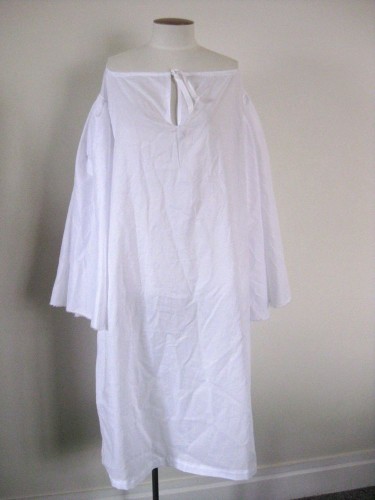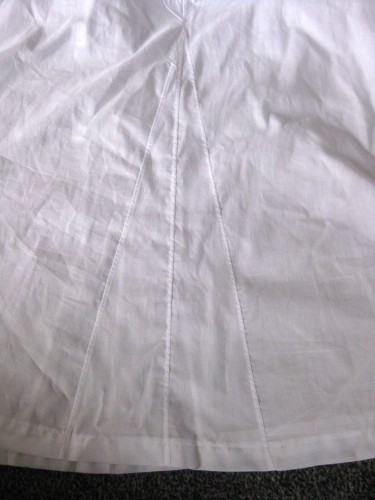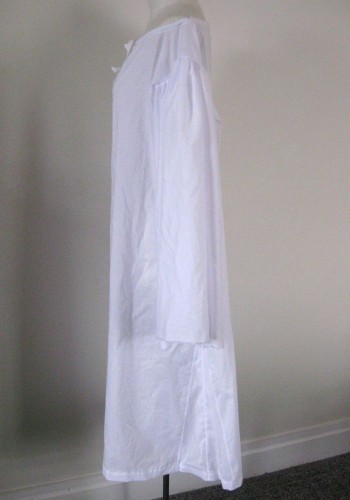In order to give myself a break from the endless eyelets, I whipped up a shift to go under Ninon’s dress.
Unlike the rest of the dress, I can’t claim historical accuracy with the shift.
I couldn’t find enough resources on 17th century undergarments to feel that I could draft a pattern and construct a shift that would be accurate so I figured why bother with all the handsewing and expensive linen and other nitpicky details that go with accuracy?
So my shift is cotton. (*gasp*)
And almost entirely machine sewn. (*double gasp*)
So, no, it’s not accurate, but I did try my best to do the proper research.
My pattern is a mash of the two 17th c shift/chemise patterns I could find: the 1660s (but very old-fashioned for that date, so more like 1600) Catherine of Braganza shift in Patterns of Fashion 4, and a ca. 1700 shift depicted in Willet and Cunnington’s ‘The History of Underclothes’; as well as the standard 18th century shift pattern.
I used the full sleeves and small undersleeve gore from the Braganza shift, the shallow rounded square neckline & slit front from the ca 1700 shift, and the side triangles and general construction methods of an 18th century shift.
I did make one mistake – I cut my neckline too shallow, and so it sat a full 1 1/2″ above the neckline of my over-bodice. It was easy enough to fix – just cut down another 1 1/2″ and re-bind. All these images show the wrong neckline – I haven’t had time to re-photograph it.
The sleeves aren’t finish. I’ll hem and trim them after I do the sleeves for the bodice and can fit them together. Right now they make me giggle. They are so long and full that they remind me of the white surplices that choir boys wear. I guess that fits in with the angelic theme of the outfit!
With my neckline mistake fixed, it works. It looks like the bits of 17th century shifts that we can see in paintings, particularly in my inspiration image. And now that I know how the general idea works, I can refine it until I make one that is at least plausibly perfectly historical.
I might even do a tutorial on how I did it if anyone is interested.







YES! TUTORIAL!
It’s pretty!
I love the sleeves especially.
Your remark about the choir boy surplices made me laugh – my choir still wears them over black robes! They’re ridiculously hot (and they’re terrible to play handbells in) but they do give a nice uniform look 🙂 Your shift is lovely!
Gillian–you’re right about handbells! Our handbell choir has special robes with velcroed sleeve cuffs. But they’re still horribly hot!
Velcroed sleeves would be helpful! Last time we played I nearly threw a bell across the sanctuary with my sleeve (I play the octave C7-C8, so they’re itty-bitty!)
Awww…this conversation is making me nostalgic. My very first sewing teacher also taught bells, and was the conductor for the bell orchestra. We used to go to her concerts, but alas, they didn’t wear surplices!
Please do the tutorial. I have never seen one for a shift.
Oh yes, please, do a tutorial! I’ll probably use it for dolls… I have no use for 17th century, but I totally want to revisit it and do it some justice, so dolls it is… one day.
A tutorial would be marvelous! I am currently making the 1660s waistcoat from Waugh and will be making a shift to go under it. I had planned on using the pattern in the Janet Arnold #4. Thanks for posting your experiences with both these garments, I have a feeling I’ll be referring to this again and again!
Right, I will get on to that tutorial!